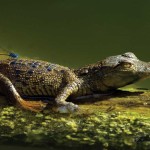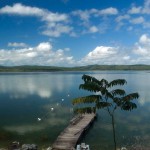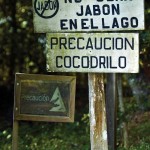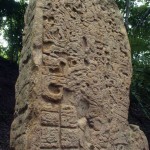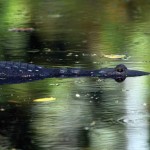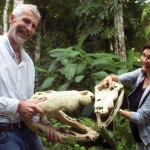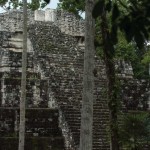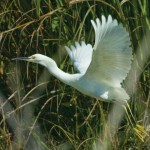Yaxhá Lagoon and the Crocs
- Croc and dragonfly
- Dock at the lagoon, swim if you dare…
- What? No swimming? He pointed to a sign: Warning Crocodiles!
- Stela in the Yaxhá archaeological site.
- Cruising crocodile, Yaxhá Lagoon
- Crocodile skulls held by Petén jungle guide Marco Gross, and Gabriella Moretti, owner of Ecolodge El Sombrero in Yaxhá
- Maya structure, Yaxhá Archaeological Park
- A local resident
There are two main gateways leading to the Mayan rainforest in the department of Petén, which forms Guatemala’s northern frontier. The main route takes you through the humid lowlands of the Motagua Valley and then north passing the magnificent Sweet River (Río Dulce), the jungle outpost of Poptún, and finally to the departmental island capital of Flores. The other, less-traveled route is via the imperial city of Cobán, and up through the land of the Kek’chi Maya and through the population centers of Chisec, Raxrulhá, Sayaché and La Libertad.
Naturally, we chose the road less traveled. Once you leave Cobán, the landscape feels like you’re back to the old days when most of the region’s rivers were crossed by ferry and where “Latin America” is left far behind as you enter the mysterious realm of Mayan America. And so it remains when you arrive at Sayaché and the roiling waters of the Río de la Passión. Waiting in a long line of vehicles for the ferry gives you time to chat with locals, drink a cold coconut juice or two and perhaps sample the street food, top on my list being Pacaya envuelta en huevo.
From Cobán to Flores it takes about six hours through some spectacularly beautiful terrain dominated by the weird limestone-karst hills and ranges. From Flores we headed due east toward Belize and several hours later came to the turnoff for Yaxhá National Park.
From the turnoff it’s another half hour to the lagoon, at the sight of which only one thought was in my mind: Remove my sweaty clothes and jump in!
Here in the sweltering jungle heat, a fantastic crystal-clear lagoon, and you can’t swim there. Then he pointed out toward the middle, where I could clearly see the ridged back of a three-meter-long crocodile slowing gliding through the water. I opted to take a cool shower at the campgrounds.
Later that afternoon I interviewed Miss Gabriella Moretti, owner of the one hotel located on the lagoon, the Sombrero Ecolodge. She told me about a memorable event that took place some years back when a tourist, purportedly none other than the royal Dutch chocolatier to the queen of Holland, went for a dip in the lagoon:
“A group of tourists from Holland were staying at El Sombrero. It was about 6 a.m. when I heard a commotion coming from the direction of the pier. I saw some of the visitors shouting in terror and waving as they helplessly watched a crocodile swimming toward a man bathing in the lagoon. I rushed down and saw a man splashing in the water, and at first thought he was drowning because he was submerging and then surfacing again while violently splashing.
“When he saw the croc he raised his arm to defend himself and this was where the two-meter-long saurian first bit him, breaking his wrist. I dove into the lagoon and swam towards the man. By now the croc had taken him by the leg and was trying to dive. At the same time several workers had jumped into the hotel skiff and were feverishly paddling toward the man, who was fighting hard for his life. Finally, as we approached the croc gave up and swam off. We managed to get the badly injured man into the skiff.
“Fortunately, he was evacuated to a hospital in Guatemala City, and I am happy to report that they were able to save his leg. It still gives me shivers to remember how, for years, we all, including my young children, would swim in the lagoon without a second thought. Since the attack we never have gone back in.”
Park guards later in the day told me that none of them even wade into the water. Nevertheless, several years back a female tourist, they informed me, would swim way out into the lagoon every day, seemingly oblivious to the presence of the big crocs. The guards would look on with a mixture of dread and amazement.
After several weeks paddling all over the Yaxhá Lagoon I know that it is literally infested with crocs and that there are many big ones in excess of three meters. You almost never see them. They are masters at being surreptitious. What looks like bubbles on the water surface are often croc eyes just emerging for a moment to get a better view—of you!
I discovered a hidden inlet formed by the high water, leading to an inundated cenote, a perfectly circular body of water with the jungle towering above. This, I found out, was the croc breeding area, and if I was quiet enough I would see literally dozens of baby crocs sunning themselves and playing around in the muck.
Next month in The Road Less Traveled: Yaxhá Sunset Party with the Oropendolas
